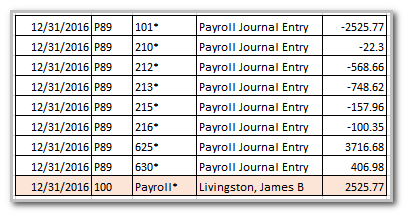We moved!
Help articles have been migrated to the new Help and Support. You can find help for your products and accounts, discover FAQs, explore training, and contact us!
You can export reports from Creative Solutions Accounting (CSA) to a Microsoft Excel format. This topic explains how to export the Transaction Listing report in Creative Solutions Accounting to Excel and provides formatting tips to help you create a spreadsheet to import transactions into Accounting CS.
Our support representatives are not trained to assist with Microsoft Office products. If you are not familiar with Microsoft Excel, we recommend that you work with someone who has experience using Microsoft Office Excel.
Notes
- If you are licensed for only Accounting CS Payroll, the application will not import journal entries.
- Payroll checks are imported as regular checks and they will not update the employee’s earnings.
- If you are running Creative Solutions Accounting on Virtual Office, refer to Accessing local and network drives through applications that run in Virtual OFfice CS or SaaS for more information on accessing your local and network drives on Virtual Office to export the report.
Creating the export file
Follow the steps below to create the export file.
- With the client open in CSA, choose Utilities > Export.
- In the Export dialog, select the Transaction Listing report.
- Click Options to select the type of transactions to export.
- In the Transaction Listing Options dialog, make the following selections based on the types of transactions you are exporting.
If you are importing checks, deposits and journals
- Click OK.
- Clear the following checkboxes:
- Include column headings, to remove merged cells from the spreadsheet and make it easier to format.
- Include carriage return at the end of each line, carriage returns are not necessary.
- Choose the DIF option in the Format area to the right of the dialog.
- Verify that the location for the file is correct, and then enter the file name to use for the report.
Use a file name you will recognize. Example, ClientIDtrans or ClientIDchecks. Keep the file extension as .DIF.
- Click the Export button to export the report to the specified location.
- Minimize the CSA window.
Locating and opening the report in Microsoft Excel
- Open Microsoft Excel.
- Choose File > Open Other Workbooks and browse to the location you exported the report.
To locate the DIF file, change file types to “All Files (*.*)".
- Use the File > Save As function to save the DIF file as an Excel workbook, rather than the DIF file. You will not be using the DIF file from this point forward.
Formatting the spreadsheet in Microsoft Excel
There are a number of steps to take within the Excel workbook to change it into a format that can be imported in Accounting CS as transactions.
Formatting for payroll transactions
Formatting for Checks and Deposits
Importing the spreadsheet into Accounting CS
Follow the steps in Spreadsheet import - transactions to import the spreadsheet into Accounting CS.
While importing the spreadsheet into Accounting CS, you will have the opportunity to:
- Import all the transactions as cleared (or not) at the Data Mapping – Bank Accounts screen. This is important if you have already completed your bank reconciliations.
- Select the specific 1099 form and box number for each vendor(s) transactions at the Data Mapping – 1099 screen.
Was this article helpful?
Thank you for the feedback!






